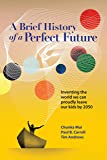 A Brief History of a Perfect Future: Inventing the World We Can Proudly Leave Our Kids by 2050. Chunka Mui, Paul Carroll, and Tim Andrews.Â
A Brief History of a Perfect Future: Inventing the World We Can Proudly Leave Our Kids by 2050. Chunka Mui, Paul Carroll, and Tim Andrews.Â
Full disclosure, I’ve known and worked with the authors for over twenty five years. I’m biased. Largely because I have first hand knowledge of how smart they are and how deeply they think.Â
In A Brief History of a Perfect Future, they take an old observation of Alan Kay’s–“the best way to predict the future is to invent it”–and turn that into a planning process you can apply yourself.Â
When the goal is invention not prediction, you want to understand what you have to work with. You’d like to work with what is cheap and readily available. Today, computing power qualifies. Thirty years ago that wasn’t the case. Fortunes were made by those who recognized that trend and acted accordingly. We’re still learning how to think about what’s possible with essentially free computation.Â
Mui, Carroll, and Andrews extend that line of thinking into seven “Laws of Zero,” These are factors of production on similar improvement paths; computation, communication, information, genomics, energy, water, and transportation. What becomes possible when you can anticipate thousand and million-fold improvements in price and performance in any one of these elements? When they improve in concert?Â
The authors play out potential scenarios in the next section of the book. What futures might we invent for ourselves? None are foreordained. None are impossible. The scenarios provided here are provocative and plausible.Â
The point, of course, is not whether these particular futures come to pass. We’re not running a race on a fixed track. We’re building new roads to new destinations. Much more fun and rewarding than chasing someone else on their road. These are traveling companions worth getting to know.
Sounds like another book to add to my holiday list; thanks for the quick review.